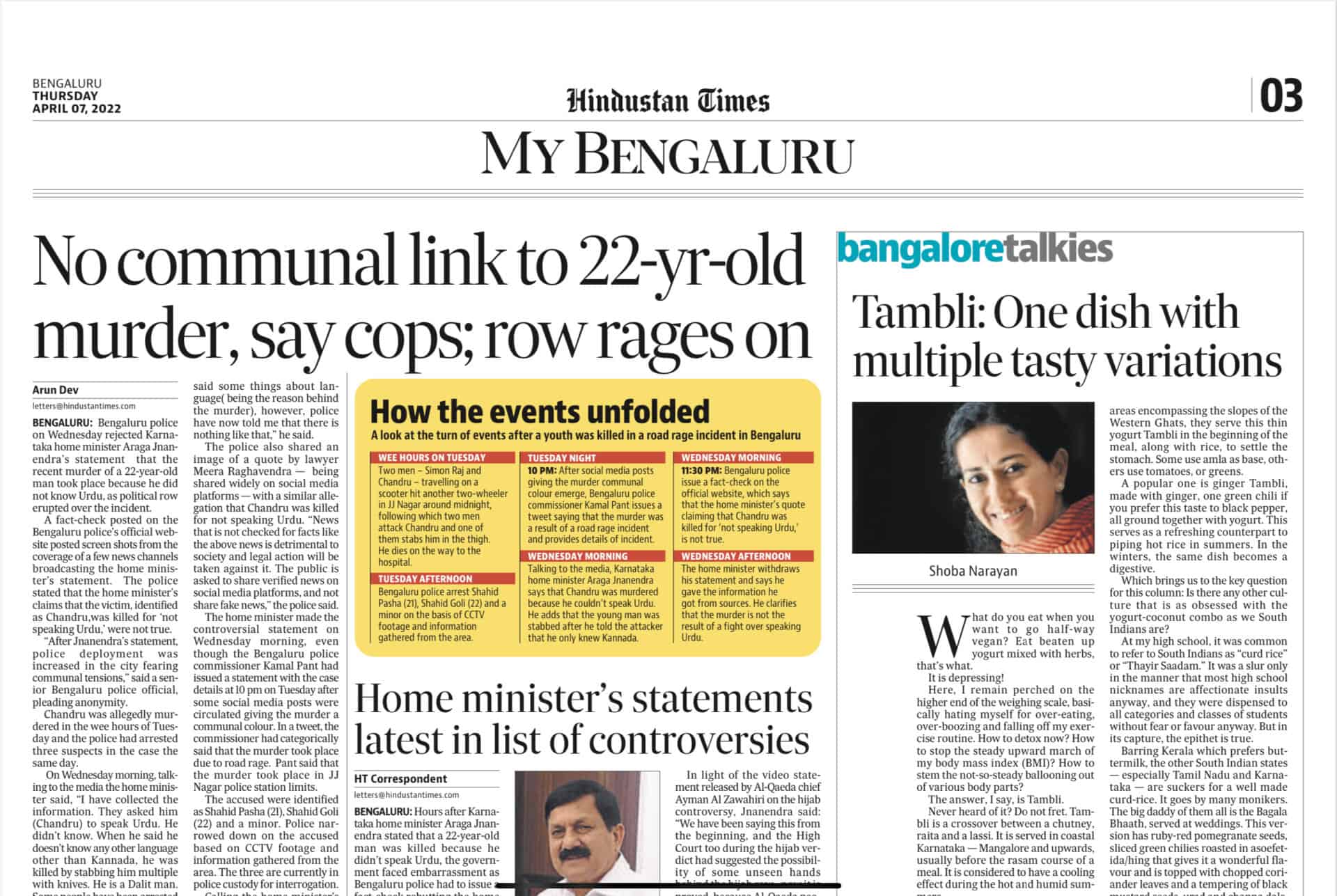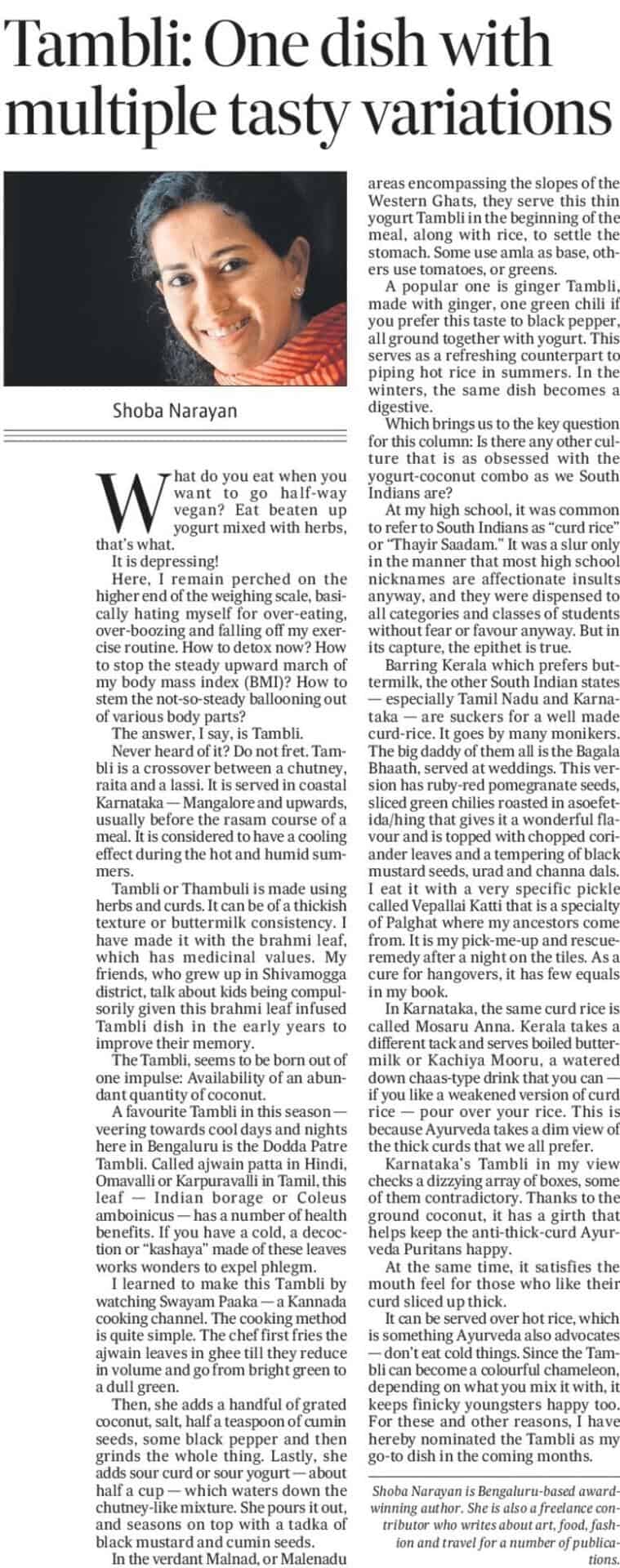Bangalore Talkies: What do you eat when you want to go half-way vegan? Eat beaten up yogurt mixed with herbs, that’s what.
Tambli: One dish with multiple tasty variations
Tambli or Thambuli is made using herbs and curds. It can be of a thickish texture or buttermilk consistency. I have made it with the brahmi leaf, which has medicinal values. My friends, who grew up in Shivamogga district, talk about kids being compulsorily given this brahmi leaf infused Tambli dish in the early years to improve their memory.

It is depressing.
Here I remain, perched on the higher end of the weighing scale, basically hating myself for over-eating, over-boozing and falling off my exercise routine. How to detox now? How now to stop the steady upward march of my Body Mass Index? How to stem the not-so-steady ballooning out of various body parts?
The answer, I say, is tambli. Never heard of it? Never mind. Tambli is a cross between a chutney, raita and a lassi. It is served in coastal Karnataka– Mangalore and upwards, usually before the rasam course of a meal. It is considered cooling during the hot and humid summers.
Tambli or Thambuli is made with herbs and curds. It can be of a thickish texture or buttermilk consistency. I have made it with the Brahmi leaf which is medicinal. My friends who grew up in Shivamogga district talk about kids being compulsorily given this brahmi-leaf tambli dish in the early years to improve their memory.
The tambli, it seems to be, was born of one impulse: the availability of an abundant quantity of coconut. A favourite tambli in this season– veering towards cool days and nights here in Bangalore is the “dodda patre” tambli. Called ajwain patta in Hindi, omavalli or karpuravalli in Tamil, this leaf– Indian borage or Coleus amboinicus– has a number of health benefits. When you have a cold, a decoction or “kashaya” made of these leaves is great to expel phlegm.
I learned to make this tambli by watching “Swayam Paaka,” a kannada cooking channel. The cooking method is quite simple. She first fries the ajwain leaves in ghee till they reduce in volume and go from bright green to a dull green. Then, she adds a handful of grated coconut, salt, half a teaspoon of cumin seeds, some black pepper and then grinds the whole thing in a mixie. Lastly, she adds sour curds or sour yogurt– about half a cup– which waters down the chutney-like mixture. She pours it out, and seasons on top with a tadka of black mustard seeds and cumin seeds.
In the verdant Malnad, or Malenadu areas encompassing the slopes of the Western ghats, they serve this thin yogurt tambli in the beginning of the meal, along with rice to settle the stomach. Some use amla as base, others use tomatoes, or greens. A popular one is ginger tambli, made with ginger, one green chili if you prefer this taste to black pepper, all ground together with yogurt. In the summer months, this serves as a refreshing counterpart to piping hot rice. In the winter months, the same dish becomes a digestive.
Which brings us to the key question for this column: is there any other culture that is as obsessed with the yogurt-coconut combo as we South Indians are?

At my high school, it was common to refer to South Indians as “curd rice” or “thayir saadam.” It was a slur only in the manner that most high school nicknames are affectionate insults anyway, and they were dispensed to all categories and classes of students without fear or favour anyway. But in its capture, the epithet is true. Barring Kerala which prefers buttermilk, the three other South Indian states, especially Tamilnadu and Karnataka are suckers for a well made curd-rice. It goes by many monikers. The big-Daddy of them all is the bagala bhaath, served at weddings. This version has ruby-red pomegranate seeds, sliced green chilies roasted in asoefetida/hing that gives it a wonderful flavour and topped with chopped coriander leaves and a tempering of black mustard seeds, urad and channa dals. I eat it with a very specific pickle called vepallai-katti that is a specialty of Palghat where my ancestors come from. It is my pick-me-up and rescue-remedy after a night on the tiles. As a cure for hangovers, it has few equals in my book.
In Karnataka, the same curd rice is called mosaru-anna. Kerala takes a different tack and serves you boiled buttermilk or “kachiya-mooru,” a watered down chaas-type drink that you can– if you like a weakened version of curd-rice– pour over your rice. This is because Ayurveda takes a dim view of the thick curds that we all prefer.
Karnataka’s tambli in my view checks a dizzying array of boxes, some of them contradictory. Thanks to the ground coconut, it has a girth that helps keep the anti-thick-curd Ayurveda Puritans happy. At the same time, it satisfies the mouth-feel for those that like their curd sliced-up thick. It can be served over hot rice, which also is something Ayurveda advocates– don’t eat cold things. Since the tambli can become a colourful chameleon, depending on what you grind, it keeps finicky youngsters happy too.
For these and other reasons, I hereby nominated the tambli as my go-to dish in these coming summer months.




Leave A Comment